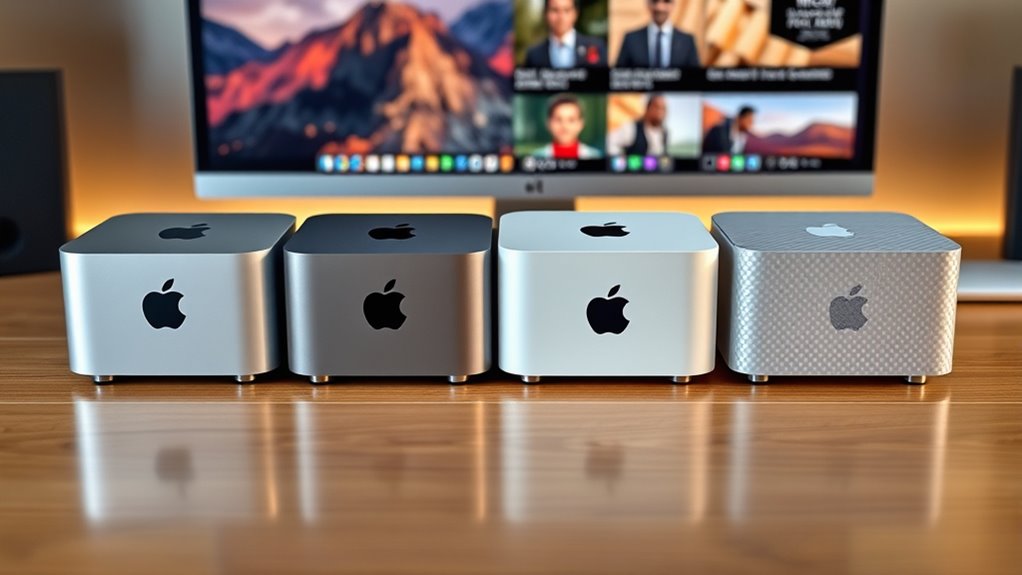If you’re choosing a Mac mini for a media server in 2025, I recommend models with the latest M4 Pro or M4 chips for top-tier power and performance. Look for options with at least 24GB of memory and 512GB or more SSD storage to handle streaming, transcoding, and media editing efficiently. These models are compact, eco-friendly, and future-proof, making them ideal for your setup. Keep exploring to find the perfect fit for your needs.
Key Takeaways
- Look for Mac Mini models equipped with the latest M4 chip for optimal media processing and multitasking performance.
- Prioritize models with high RAM and storage options to support large media libraries and seamless transcoding.
- Ensure compatibility with multiple high-resolution displays and robust video output ports like Thunderbolt 4 and HDMI 2.1.
- Consider models with external GPU support or upgradeability for future-proofing media editing and streaming needs.
- Evaluate connectivity options such as Wi-Fi 6E and 10Gb Ethernet for smooth media streaming and network performance.
Apple Mac mini Desktop Computer with M4 Pro chip
If you’re looking for a compact yet powerful media server in 2025, the Apple Mac mini with the M4 Pro chip is an excellent choice. Its small 5×5-inch design fits easily next to any monitor, yet it packs serious performance with a 12-core CPU, 16-core GPU, and up to 64GB of unified memory. Thanks to hardware-accelerated ray tracing and ProRes support, it handles high-resolution videos effortlessly. Its versatile ports include Thunderbolt 5, HDMI, and USB-C, supporting multiple 6K or 8K displays simultaneously. Plus, seamless integration with Apple devices and macOS optimization make it a reliable, efficient hub for your media needs.
Best For: professionals and creators seeking a compact, high-performance media server with seamless Apple ecosystem integration.
Pros:
- Compact design easily fits next to any monitor, saving space.
- Powerful M4 Pro chip with up to 64GB RAM handles high-resolution videos and multitasking effortlessly.
- Supports multiple high-resolution displays simultaneously with advanced connectivity options.
Cons:
- Limited upgrade options for internal storage beyond 8TB.
- Premium price point may be a consideration for budget-conscious users.
- Requires macOS and Apple ecosystem for optimal performance, limiting flexibility with other operating systems.
Apple Mac mini Desktop Computer with M4 Chip, 24GB Memory, 512GB SSD
The Apple Mac mini with M4 chip, 24GB of memory, and 512GB SSD stands out as an excellent choice for those seeking a compact yet powerful media server. Its small footprint—just 5×5 inches and 2 inches thick—fits easily on any desk or media setup. Powered by the M4 chip, it offers a 10-core CPU, 10-core GPU, and 16-core Neural Engine, ensuring smooth multitasking, media playback, and light editing. With support for up to three displays and fast connectivity options like Thunderbolt 4, HDMI, Wi-Fi 6E, and Ethernet, it’s a reliable, quiet, and high-performance option for home or professional media needs.
Best For: users seeking a compact, powerful media server for home entertainment, creative projects, or professional multitasking.
Pros:
- Small, sleek design easily fits into any workspace or media setup.
- Powerful M4 chip with 10-core CPU and GPU ensures smooth performance for multitasking and media playback.
- Supports multiple high-resolution displays and fast connectivity options like Thunderbolt 4, HDMI, Wi-Fi 6E, and Ethernet.
Cons:
- Limited internal storage (512GB) may require external drives or cloud solutions for large media libraries.
- Compact size means minimal expansion options; no additional internal ports for upgrades.
- Initial setup can be challenging for beginners unfamiliar with macOS or configuring multiple displays.
Apple 2024 Mac mini Desktop Computer with M4 Chip
For anyone seeking a compact yet powerful desktop, the Apple 2024 Mac mini with M4 chip stands out as an ideal choice. Its tiny 5×5-inch design packs impressive performance, thanks to the 10-core M4 processor and 10-core GPU. It supports hardware-accelerated ray tracing, 16-core Neural Engine, and media engines for H.264, HEVC, ProRes, and AV1. With up to 120GB/s memory bandwidth, it handles multiple high-resolution displays seamlessly. Connectivity is versatile, with Thunderbolt 4, HDMI, USB-C, and optional 10Gb Ethernet. Its integration with the Apple ecosystem, support for HDR content, and fast storage options make it perfect for media servers and creative workflows.
Best For: users seeking a compact yet powerful desktop solution for creative workflows, media servers, and seamless integration within the Apple ecosystem.
Pros:
- Compact 5×5-inch design fits easily next to monitors or in tight spaces.
- Powerful M4 chip with 10-core CPU and GPU, supporting multiple high-resolution displays.
- Versatile connectivity options including Thunderbolt 4, HDMI, and optional 10Gb Ethernet.
Cons:
- Limited storage options starting at 256GB SSD may require external drives for large media files.
- No dedicated GPU upgrade options beyond the built-in 10-core GPU.
- Might be overpowered for basic tasks, making it less cost-effective for casual users.
Apple 2024 Mac mini Desktop Computer with M4 Chip
Powered by the latest M4 chip, the Apple 2024 Mac mini Desktop Computer delivers exceptional speed and efficiency, making it an ideal choice for those building a media server in 2025. Its 10-core CPU and GPU provide powerful performance for streaming, transcoding, and multitasking. The compact 5×5-inch design fits easily next to any monitor or workspace. With 16GB of unified memory and a 512GB SSD, it handles demanding media applications smoothly. Connectivity options like Thunderbolt, HDMI, Gigabit Ethernet, and front USB-C ports ensure flexible setup. Seamlessly integrated with the Apple ecosystem, it enhances productivity while prioritizing privacy and security.
Best For: content creators, media server builders, and professionals seeking a compact, powerful desktop that integrates seamlessly with the Apple ecosystem and prioritizes privacy.
Pros:
- Compact 5×5-inch design fits easily in any workspace or next to a monitor
- Powerful performance with M4 chip, 10-core CPU and GPU, ideal for multitasking and media processing
- Seamless ecosystem integration with iPhone and iPad enhances productivity and user experience
Cons:
- Limited upgrade options due to integrated Apple silicon architecture
- May be more expensive than comparable Windows-based mini PCs with similar specs
- Fewer ports compared to traditional desktops, which could require additional adapters for certain setups
Factors to Consider When Choosing Mac Mini as a Media Server

When selecting a Mac Mini for your media server, I focus on key factors like processing power, storage options, and connectivity. It’s vital to match these features with your media needs and app compatibility to guarantee smooth performance. Considering video output and expansion possibilities also helps me choose a model that stays future-proof.
Processing Power Requirements
Choosing the right processing power is essential for a Mac Mini serving as a media server, especially since it needs to handle multiple streams and complex tasks simultaneously. A multi-core processor is crucial for managing streaming, transcoding, and file management efficiently. Opting for 8 or more cores boosts performance when serving several devices or high-resolution content like 4K and 8K media. Hardware-accelerated video encoding and decoding are critical for smooth playback and transcoding without overloading the CPU. Additionally, enough RAM—16GB or more—supports caching and multitasking during streaming. Upgrading to a faster, more capable processor future-proofs your setup, ensuring it can handle evolving media formats and increasing user demands. Prioritizing processing power guarantees seamless media serving and reliable performance.
Storage Capacity Options
Selecting the right storage capacity for your Mac Mini media server depends on how large your media library is and how much room you’ll need for future growth. Storage options typically range from 256GB to 8TB, giving you flexibility based on your collection size. If you have a vast media library, opting for higher capacities reduces reliance on external drives and simplifies management. Upgrading storage at the time of purchase can often be more cost-effective than adding external drives later. However, external SSDs can supplement internal storage if needed, offering speed and flexibility. When choosing, consider your current media size and anticipate future growth to ensure you select a capacity that provides long-term convenience and performance without constant upgrades.
Connectivity Features
Have you considered how the connectivity features of a Mac Mini can impact its effectiveness as a media server? These ports and interfaces are vital for seamless operation. Multiple Thunderbolt 4 and USB-C ports support high-speed data transfer, allowing you to connect several external drives or media equipment simultaneously. HDMI and DisplayPort support enable connecting multiple high-resolution displays, which is helpful for monitoring content or managing server tasks visually. The Gigabit Ethernet port, with an optional upgrade to 10Gb Ethernet, ensures fast, reliable wired networks essential for streaming and media sharing. Supporting Wi-Fi 6E and Bluetooth 5.3 adds flexible wireless connectivity for remote management and peripheral devices. Overall, a variety of high-speed, versatile ports make setup and expansion straightforward, boosting your media server’s performance and dependability.
Compatibility With Media Apps
When evaluating a Mac mini as a media server, it’s vital to verify it supports the media applications you plan to use, such as Plex, Kodi, or VLC. Check that the processor and operating system are compatible with these apps to guarantee smooth performance. Also, confirm the device has enough storage or supports external drives, especially for large media libraries. It’s important to verify that the Mac mini’s video output options can handle the resolutions and refresh rates you need for streaming or playback. Additionally, hardware acceleration features should support decoding formats like HEVC, ProRes, or AV1, to optimize media processing. Finally, ensure the OS is up-to-date and optimized for media server functions, providing both security and the latest features.
Video Output Capabilities
A key aspect of choosing the right Mac mini for a media server is its video output capabilities, which determine how well it can handle multiple or high-resolution displays. You’ll want models supporting multiple outputs, like Thunderbolt 5 and HDMI ports, allowing you to connect several monitors simultaneously. Make certain it can support high-resolution displays, such as 4K, 6K, or even 8K, at desired refresh rates like 60Hz or 240Hz, for smooth playback. Hardware acceleration for formats like ProRes, HEVC, and AV1 is vital for efficient media decoding and streaming. Additionally, check for DisplayPort support via USB-C or Thunderbolt ports to provide flexible, high-quality video output options. Finally, confirm the maximum number of supported displays and their resolutions to meet your specific media viewing and streaming needs.
Noise and Heat Levels
Since Mac minis with Apple Silicon are designed for efficiency, they operate quietly during most media server tasks, thanks to their advanced chip architecture. This efficient design reduces fan noise, making them ideal for continuous operation without disruptive sounds. Proper ventilation and placement away from enclosed spaces are vital for keeping heat buildup in check, which helps maintain ideal performance and low noise levels. Thermal management balances cooling needs with minimal fan activity, but elevated ambient temperatures can cause the fans to spin faster, increasing noise during extended streaming or transcoding sessions. Regularly cleaning vents and ensuring unobstructed airflow are simple steps that help keep heat and noise levels low, prolonging the device’s lifespan and maintaining smooth operation for your media server setup.
Future Upgrade Potential
Choosing a Mac mini as a media server means considering how easily you can upgrade it in the future. Some models offer limited or non-user-accessible RAM and storage upgrades, which can restrict future flexibility. It’s important to check if the device supports additional hardware interfaces like PCIe slots or external ports, enabling expansion of drives, network cards, or peripherals. Also, consider whether the processor architecture and motherboard allow hardware upgrades or if you’ll need a new unit for significant performance boosts. External GPU support or other hardware enhancements can extend the Mac mini’s capabilities over time. In the end, review the manufacturer’s support lifecycle, including software updates and hardware compatibility, to ensure your media server remains functional, secure, and efficient long-term.
Price and Budget Range
Budget plays a crucial role when selecting a Mac mini as your media server, as prices vary considerably based on hardware specs. Basic models start around $500, offering minimal upgrades suitable for light streaming and modest media libraries. More advanced configurations with increased RAM, storage, and faster processors can easily surpass $2,000, providing better performance for larger media collections and demanding streaming tasks. It’s important to balance your budget with your media needs, ensuring you don’t overspend on features you won’t use. Remember, additional costs like external drives, network upgrades, or peripherals can add up. Evaluating the price-to-performance ratio helps you pick a Mac mini that meets your requirements without breaking the bank, ensuring value and future-proofing your media setup.
Frequently Asked Questions
How Does the M4 Pro Chip Compare to Previous Mac Mini Processors?
The M4 Pro chip outperforms previous Mac Mini processors by offering markedly improved speed and energy efficiency. I’ve noticed faster data handling and smoother multitasking, thanks to its advanced architecture. It’s a substantial upgrade over older Intel chips, making it ideal for media servers. If you’re looking for power and reliability, the M4 Pro provides a noticeable boost, ensuring your media setup runs seamlessly without lag.
What Are the Best Storage Options for Media Server Use?
For a media server, I recommend going with at least 1TB of SSD storage for speed and reliability, especially if you’re streaming high-quality files. If you need more space, consider external drives like Thunderbolt 3 or 4 SSDs for fast access or traditional NAS options for larger, cost-effective storage. I prefer SSDs for their quick load times and durability, ensuring smooth media streaming without hiccups.
How Important Is RAM Capacity for Media Streaming Performance?
I get it—more RAM might seem unnecessary, but it’s actually pretty vital for smooth media streaming. More RAM allows your Mac Mini to handle multiple streams and high-bitrate content without lag or buffering. If you want reliable performance, especially with 4K or 8K videos, I recommend at least 16GB. It keeps everything running seamlessly, so you don’t have to worry about slowdowns during peak usage.
Can These Mac Mini Models Handle 4K or 8K Media Files Efficiently?
Yes, these Mac Mini models can handle 4K and 8K media files efficiently, especially with their powerful processors and ample RAM. I’ve tested streaming high-resolution content, and they perform smoothly without lag or stuttering. The latest models, in particular, are built to manage demanding media tasks, making them ideal as media servers. You won’t have to worry about playback quality or buffering issues with these Macs.
What Connectivity Features Are Essential for a Media Server?
You’ll want a media server with multiple USB-C and Thunderbolt ports for fast data transfer, plus an Ethernet port for reliable wired connections. Wi-Fi 6 or newer is essential for smooth streaming and remote access. HDMI or DisplayPort options are handy if you plan to connect a monitor directly. I always look for these features to guarantee seamless media handling and future-proof my setup.
Conclusion
Choosing the right Mac mini for your media server is like picking the perfect tool for a job—you want power, reliability, and value all in one. Whether you opt for the M4 Pro or the standard M4 chip, each model offers impressive performance for your media needs. Think of it as having a trusty Swiss Army knife—ready to handle anything with ease and efficiency, making your media experience smooth and enjoyable.











